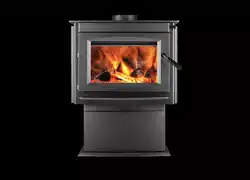Loading ...
Loading ...
Loading ...

EN
W415-2796 / D / 05.07.21
7
general information
This appliance was specifically designed over many months
of research to meet the 2020 U.S.A. EPA particulate emission
standards and has been extensively tested in Canadian
laboratories. This sytem is the most efficient, simple and trouble-
free we know and works as follows:
Secondary air from the rear opening travels up the back in the
secondary air housing to the manifold located at the top and
shoots out laterally to oxidize the gases below the smoke exit.
The lower combustion chamber is lined with high temperature
firebricks on 2 sides, the back and across the bottom, with a layer
of fibre baffles at the top to maintain a high temperature in the
combustion chamber so that gases mixing with the preheated
air from the secondary air manifold tube are easily ignited and
burned. The appliance sides and back are shielded to direct the
heat upwards and forwards into the room.
Be sure to provide sufficient combustion air. There are many other
appliances in your home competing for air such as: a kitchen range hood, forced air heating devices, clothes dryer or a
bathroom exhaust blower.
After extended periods of non-operation such as following a vacation or a warm weather season, the appliance may
emit a slight odour for a few hours. This is caused by dust particles on the firebox burning off. Open a window to
sufficiently ventilate the room.
If you experience smoking problems, you may need to open a door, a window or otherwise provide some method
of supplying combustion air to the appliance.
Do not use makeshift compromises during installation. Do not block or restrict air, grille, or louvre openings. Do
not add a hood. Burning your appliance with the door open or ajar creates a fire hazard that may result in a house
and/or chimney fire.
All venting connections must be in compliance with the chimney manufacturer’s installation instructions.
Clearances referred to throughout this manual are the minimum requirements.
Your appliance must be installed in accordance with all national and local building code standards and the
standard of Chimney and Appliances, Vents and Solid Fuel Burning Appliances NFPA #211. Consult the authority
having jurisdiction (such as municipal building department, fire department, fire prevention bureau, etc.) to
determine the need to obtain a permit. If you are in doubt about the proper installation for your situation, contact
your dealer or local building or fire official. The manufacturer does not guarantee that this appliance and its options
will completely heat your entire home.
Expansion / contraction noises during heating up and cooling
down cycles are normal and to be expected.
It is recommended that in all cases, the appliance be secured
to the floor.
1.4 general information
!
WARNING
• Do not operate this appliance without the pedestal installed.
AIR INLET PATH
EXHAUST PATH
Loading ...
Loading ...
Loading ...
